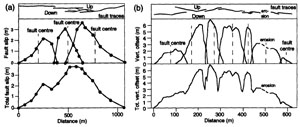| |||||||
|
|
|||||||
|
|
|||||||
| Slip Distribution along Faults with Unidentified Formation Mechanism | |||||||
|
Displacement or slip varies along a fault trace for both single-segment faults and faults with multiple segments. For faults composed of a single segment, in general, displacement is maximum around the middle of the fault and decreases towards the end. For faults with multiple segments, Dawers and Anders (1995) showed slip distribution data from field observations for two normal faults (Figure 1). Despite the irregularities in the fault geometry, it can be recognized that 1) the point of maximum fault slip is generally not located at the center of a fault or fault segment; 2) the central part of the fault has more symmetric slip distributions; 3) the fault overlap area has steeper slip gradients; and 4) the central part has the steepest average slip gradients. Willemse (1994, 1995) and Willemse et al. (1996) used numerical analyses of fault interaction to analyze the fault slip distribution data. Their analysis indicated that interaction between neighboring faults and fault segments is an important factor in the slip distribution. | |||||||
| Reference: |
|||||||
| Cowie, P.A., Shipton, Z.K., 1998 Dawers, N., Anders, M., 1995 Walsh, J.J., Watterson, J., 1991 Willemse, E.J.M, 1994 Willemse, E.J.M, 1995 Willemse, E.J.M, Pollard, D.D., Aydin, A., 1996 |
|||||||
|
Readme | About Us | Acknowledgement | How to Cite | Terms of Use | Ⓒ Rock Fracture Knowledgebase |
|||||||
